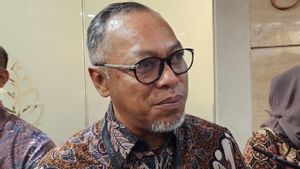JAKARTA - Nowadays, gadgets have become a necessity for modern society. No longer as a complementary tool for lifestyle (lifestyle), the use of gadgets is our way of life today (way of life).
Based on the We Are Social report in February 2022, internet users in Indonesia reached 204.7 million or 73.7% of the total population. Of these internet users, 96% access the internet via smart phones.
Gadgets, especially for teenagers, have various features, such as a double-edged knife which has a lot of benefits but can also be dangerous if used incorrectly. Data from the Ministry of Communication and Information in 2018 stated that 65.34 percent of individuals aged 9-19 years old used the internet. In this age range, 93.52 percent of users focus more on social media other than YouTube and online games.
The Satkaara Sharing Teacher Community (KGSB) in collaboration with the BK Teacher's House (RGBK) held a KGSB Webinar entitled Youth and Devices on Saturday, May 14, 2022. This webinar aims to provide insight to teachers on how to educate students on the proper use of gadgets.

Attended by hundreds of teachers and lecturers from PAUD to Universities in Indonesia and Timor Leste, this webinar presented two resource persons who were experts in psychology and education, namely the Secretary of the Psychology Undergraduate Study Program/Clinical Psychologist, Faculty of Psychology UNIKA Atma Jaya, Nanda Rosalia, M. Psi and Founder of the BK Teacher's House and Widyaiswara Kemendikbud, Research and Technology RI, Ana Susanti, M.Pd. CEP, CHt.
The founder of KGSB, Ruth Andriani said that we cannot remove gadgets from the youth of today. Because the use of gadgets and the internet is part of the changing times that we cannot resist.
“During the pandemic, the use of the internet and gadgets has become more and more familiar to teenagers. In the world of education, technological advances also require teachers to participate in educating students to be wise in using gadgets," said Ruth.
Secretary of the Psychology Undergraduate Study Program/Clinical Psychologist, Faculty of Psychology UNIKA Atma Jaya, Nanda Rosalia in her presentation stated that so far the negative side of gadgets has received more attention than the positive side. In fact, for the current generation, doing something without the help of a device feels like an obstacle.
Good use of technology or positive technology is a scientific and applied approach to improve the quality of personal experience so that you are more prosperous, have personal strength and resilience in society.
There are at least three uses of positive technology in adolescents, including the first for the enjoyment of life which makes themselves feel comfortable, happy, and feel various positive emotions. For example listening to your favorite music, playing games and so on.

Second, self-development which aims to make oneself feel meaningful. For example, learning via YouTube and Google or developing hobbies and skills, e-training and so on. Third, social relations to connect with other people or communities, as well as participate and share. Examples are social media and social fundraising.
“Changes in the physical, cognitive, and socioemotional aspects also have an impact on the social aspects of adolescents. In this case, peers have a greater influence than family. Currently, technology and social media have even become tools for teenagers to find their identity by finding an environment that they feel comfortable in,” said Nanda.
Still in his presentation, Nanda said that a teacher must be good at using technology in order to guide students in using positive technology from gadgets, such as giving assignments that use technology. Many teachers can do in utilizing gadget technology. For example, in utilizing social media, teachers must understand the social media that they want to use and also be easy for all students to understand.
Modern teachers are not enough to only be able to use the latest technology but also have to be able to build a sense of pleasure in learning which then raises the critical thinking power and creative spirit of their students. For this reason, it is the teacher's job to continue to provide a human touch that keeps children polite, empathetic and social.
Founder of Rumah Guru BK and Widyaiswara Kemendikbud, Research and Technology RI, Ana Susanti explained that based on the results of a survey by Gregoria Serra, Unit of Pediatrics, Campus Bio-Medico University, Rome, Italy in July 2021, there was a change in the purpose of using smartphones among teenagers during the COVID-19 pandemic compared to pre-epidemic. This survey was conducted on Italian children aged 6-18 years.
During the pandemic, smartphone use is focused on human connection, learning and entertainment. There was a significant increase in overuse and addiction. Prior to the pandemic, fewer children were addicted to devices than children at high risk of addiction. Ironically after the pandemic, the number of children at risk decreased, but children who were addicted to devices increased.
“We as educators must be aware of the potential risks associated with the inappropriate use of smartphones. One of the BK teachers' roles is to monitor, work with parents, see possible side effects related to recognizing early signs and symptoms that lead to or are at high risk of addiction," Ana Susanti added.
"Collaboration is key in monitoring. Counseling teachers need to make the necessary interventions to prevent or reduce the detrimental impact of excessive smartphone use on the health of children and adolescents. The focus is on the health of children and adolescents, which is oriented towards maintaining adequate physical and psychological development and relationships healthy social," concluded Ana.
The English, Chinese, Japanese, Arabic, and French versions are automatically generated by the AI. So there may still be inaccuracies in translating, please always see Indonesian as our main language. (system supported by DigitalSiber.id)













